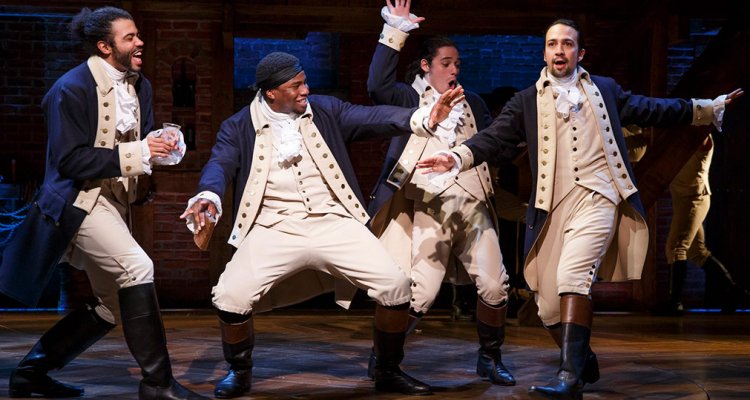Watching “Hamilton” on Disney+ is basically a two-and-a-half-hour adventure in a time machine. We aren’t living in the same world we were in 2016, the year this particular performance of Lin-Manuel Miranda’s colossal, pop culture terraforming Broadway musical was shot at New York City’s Richard Rodgers Theatre. It’s 2020. Life is considerably bleaker than it was four years ago, not just for America but the whole damn world, wracked by the COVID-19 pandemic, protests due to systemic racism, a planet under duress from climate change, and too many nations to count whose leaders are either Bond villains or idiotic tyrants.
But for the duration of “Hamilton,” and for the price of a Disney+ streaming subscription, you can escape 2020 and remember June 2016, and perhaps, more importantly, to watch up close the explosive talents of the award-winning show’s original principal cast, something relatively few people, even people who paid for the privilege of seeing the show live, were able to witness. Save for those with the deepest pockets, nobody’s gotten this close to Miranda, Leslie Odom Jr., Daveed Diggs, Renée Elise Goldsberry, Phillipa Soo, Anthony Ramos, and all the rest. Frankly, if Jonathan Groff’s geysers of saliva have anything to say about it, nobody should really want to be this close to the stage.
Now, “Hamilton” is available to all for a pittance compared to what it took to get through the doors—even for the North American tour with a very different group of performers. This feels appropriate for a telling of America’s birth authored and performed chiefly by Black, Asian, and Latino Americans, contrasting with a predominantly white American audience.
After acclimating to the topsy-turvy issue of the time discrepancy, “Hamilton” is a joy. Do not watch expecting superlative camerawork; here the lens is functional, a tool to capture a performance rather than facilitate it because cinema and theater are different mediums no matter their common roots. Cinematographer Declan Quinn’s work is admirably dutiful. However, the real superlatives are earned by Miranda, by Odom Jr., by Goldsberry and Soo, and by the players who assume dual roles: Diggs starring as both Lafayette and Thomas Jefferson; Ramos starring as John Laurens and Philip Hamilton; Okieriete Onaodowan starring as Hercules Mulligan and James Madison; Jasmine Cephas Jones starring as Peggy Schuyler and Maria Reynolds.
Seeing these performers embody their characters means seeing people sink into history, and into complication, because the story of how American was fought into existence by patriots trapped under the bootheel of the British monarchy is a tangle of heroism and bravery but also brutality. What, for instance, does it mean for a Black man to portray Jefferson as a layabout and, of course, an owner of slaves and plantations? Is this an act of exploration or reconciliation? Is this about reclaiming a history that robbed Black Americans of their humanity, asserting will over that narrative as a means of healing old wounds? The trick is that those wounds remain, and they’re as open as ever: Observe nationwide protests launched in defiance against police violence and state-sanctioned murder at the hands of an insular, coddled law enforcement body.
Maybe current events necessitate “Hamilton’s” early release to streaming. Prior to the COVID-19 pandemic that has ravaged the globe, Disney planned to drop the film in October 2021. There are likely a number of reasons for releasing the production now, but the timing reads as intentionally palliative, too. “Hamilton” is a tonic. The whole thing ends in tears, certainly, and tragedy is sprinkled throughout, but there’s joy in the craft and elation in the performances. As much as “Hamilton” is about reinterpreting history, it’s also about the sheer excitement of putting on a show.
Every shimmy, kick, spin, hook and sweep; every sideways glance and smirk, every stretched neck tendon, every warm smile; they’re all there for us to soak in. The combined effect is a cure-all for woe. “Hamilton” can’t solve the problems staring us down. That’s a ridiculous thing to expect. But it can give us a brief respite from those problems, and even provide a new framework with which to understand them. People can change the world when facing down seemingly insurmountable darkness; it’s a tall order, but it’s possible. That’s the kind of spirit people need—not just now but to the end of 2020 and beyond. “Hamilton” argues that we can make the world better, no matter that we can’t exactly make it safe and sound. It was an idea worth presenting in 2016. It’s an idea that needs presenting again in 2020. [B+]
“Hamilton” premieres on Disney+ on July 3.

